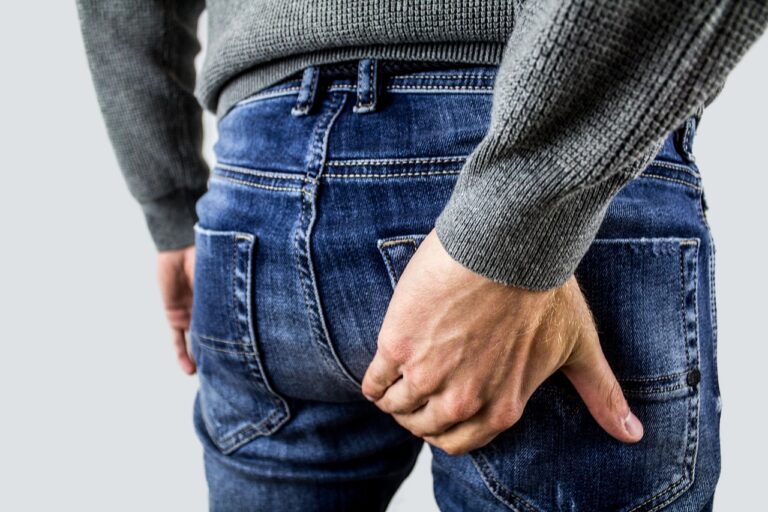Skin tags can be very itchy and painful, especially around the anus. They may bleed or swell occasionally.
To prevent them, apply lubricant before bowel movements and wipe gently. A dietary change to a more fibre-rich diet can help reduce symptoms. Also, avoiding straining while going to the toilet and rubbing the area after bowel movements can prevent skin tag formation.
Removal
Skin tags on the anus are usually easily identifiable as a small growth of excess skin. They can be quite itchy or painful, but they don’t usually need to be removed, unless they are causing issues with the genital area. If you have persistent anal skin tags, it’s best to see a gastroenterologist, who can provide treatment without causing further complications.
Luckily, the removal of anal skin tags is generally simple and a routine office procedure, with minimal discomfort. Typically, a numbing medication will be applied around the skin tag before it is cut off. The doctor can remove the skin tag with scissors or use a more advanced technique called cryotherapy, which involves freezing the skin tag with liquid nitrogen. Alternatively, electrodesiccation can be used, which involves using an electrical current to dry out the skin tag.
Following the removal of anal skin tags, you will be advised to relax at home and avoid heavy lifting or strenuous exercise. Your doctor may recommend the use of antibiotic and antifungal cream, alongside topical analgesics such as Nitroglycerin or Diltiazem to promote healing and decrease pain.
Some people may experience a yellow fluid discharge from the anal wound after skin tag removal. This is normal and does not indicate infection, as the yellow fluid is merely the serous fluid created by the wound trying to heal. However, if the wound becomes red and warm, it is important to consult your colorectal surgeon for assessment as this can be an early warning sign of anal fissure, which requires immediate attention.
Aftercare
Skin tags in this area often develop because of friction and irritation, usually when a person is sitting for extended periods of time. They can also develop if they are overweight, as extra tissue in the region will cause friction against the anus when it moves around during bowel movements. Hormonal changes can also lead to the development of anal skin tags, as can pregnancy. These growths may be a sign of an underlying medical condition like Crohn’s disease, so it is important to see a doctor if you notice these symptoms.
Treatment for anal skin tags involves removing the excess tissue with a scalpel or scissors. This is generally an in-office procedure that can be done quickly and comfortably. The doctor will inject a numbing agent around the skin tag to reduce any pain or discomfort during the removal process.
After anal skin tag removal, it is important to follow the doctor’s aftercare instructions. This will help to prevent infection at the site of the removal and will also reduce any sensitivity or pain in the days following the procedure. Your doctor may recommend taking a laxative or trying a liquid diet in the first few days to make bowel movements easier and reduce your risk of constipation. You may also be given a topical pain cream to use when you feel any discomfort in the area of your anus after treatment.
Anal skin tags are usually harmless and do not need to be removed but if they start to grow or cause pain they should be checked as it could be the sign of a more serious problem such as anal haemorrhoids. It is also important to keep the area clean and sanitised as this can help prevent further issues and avoid friction which can lead to new skin tag formation.
Hemorrhoids and anal skin tags are often linked as swollen blood vessels in the area can lead to both conditions developing. Hemorrhoids can develop as a result of excessive straining during bowel movements or due to other factors such as obesity, chronic constipation, pregnancy and childbirth. The increased pressure from anal skin tags can also cause the formation of anal fissures which are small tears or cracks in the rectum wall and can be painful and itchy.
To help prevent anal skin tags from forming you can use a lubricant to help the stool pass more easily, try drinking plenty of fluids and take a fibre supplement. You can also buy a special stool softener that will help to make the stools softer and easier to pass. It is recommended that you visit a doctor for a history and physical exam to help identify any underlying conditions that may be contributing to the anal skin tags such as Crohn’s disease or other gastroenterological problems.
Contact Us
Skin tags are small, flappy bits of excess skin that hang around the anus. They can cause itching, irritation and soiling issues. They are more common in obese individuals and those who have bowel problems such as Crohn’s disease.
Skin Tags in the anal area are usually caused by a previous flare up of hemorrhoids. The blood vessels swell and stretch the surrounding skin. After the swollen blood vessels shrink, the loose skin remains and forms an anal skin tag. They can also be due to inflammatory lesions or anal injury or as a side effect of certain hemorrhoid treatments.
Getting anal skin tags removed is a relatively simple, routine office procedure. A numbing solution is applied before the procedure and your doctor removes the skin tag with scissors, a scalpel or a laser. Cryosurgery is another option. Liquid nitrogen freezes the skin tag and it falls off within a few days without requiring further treatment.
It’s important to have any bumps or lumps on the anus evaluated by a medical professional to confirm that they are skin tags and not something more serious, such as a tumor or blood clot. Attempting to cut off anal skin tags at home can be very dangerous and lead to infections or additional complications.
See Also:


